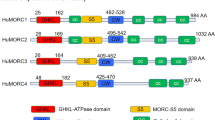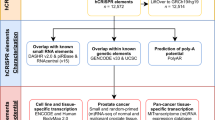Abstract
We isolated several related but distinct cDNA clones encoding novel structure proteins (NSP) when screening a cDNA library. Analysis revealed that these cDNAs and several similar ESTs in the public databases are derived from a single gene of 17 exons that span a minimum of 227-kb region. This gene is located at chromosome 17p11.2, a region frequently amplified in human gliomas and osteosarcomas, and involved in Birt–Hogg–Dube syndrome, a tumor-prone syndrome. The major coding sequences shared by all isolated transcripts are predicted to encode SMC (structural maintenance of chromosome)/SbcC ATPase motifs and coiled-coil domains commonly seen in motor or structure proteins. Two 5′-end and two 3′-end variants (type 5α/β and 3α/β, respectively) were identified, making a total of four possible transcripts. Both 5α and 5β variants were detected in human testis mRNA, but only type 5α was detectable in RNA samples extracted from HeLa cells. The unique carboxyl-terminus of 3β contains a Ca2+-dependent actin-binding domain. Immunohistochemistry studies revealed that NSPs were mostly localized to nuclei. Northern blot analysis demonstrated two major bands and the expression levels are tremendously high in testis while barely detectable in other normal tissues examined. Interestingly, NSP5α3α is highly expressed in some tumor cell lines. These results suggest that NSPs represent a new family of structure proteins with a possible role in nuclear dynamics during cell division, and that NSP5α3α may serve as a tumor marker.
This is a preview of subscription content, access via your institution
Access options
Subscribe to this journal
Receive 50 print issues and online access
$259.00 per year
only $5.18 per issue
Buy this article
- Purchase on Springer Link
- Instant access to full article PDF
Prices may be subject to local taxes which are calculated during checkout







Similar content being viewed by others
References
Allen DL and Leinwand LA . (2002). J. Biol. Chem., 277, 45323–45330.
Ample C and Vandekerckhove J . (1994). Semin. Cell Biol., 5, 175–182.
Banuelos S, Saraste M and Garugo KD . (1998). Structure, 6, 1419–1431.
Britton RA, Lin DC and Grossman AD . (1998). Genes Dev., 12, 1254–1259.
Carugo KD, Banuelos S and Saraste M . (1997). Nat. Struct. Biol., 4, 175–179.
Chan GK, Schaar BT and Yen TJ . (1998). J. Cell. Biol., 143, 49–63.
Cobbe N and Heck MM . (2000). J. Struct. Biol., 129, 123–143.
Connelly JC, de Leau ES, Okely EA and Leach DR . (1997). J. Biol. Chem., 272, 19819–19826.
Connelly JC, Kirkham LA and Leach DR . (1998). Proc. Natl. Acad. Sci. USA, 95, 7969–7974.
Fry AM, Mayor T, Meraldi P, Stierhof YD, Tanaka K and Nigg EA . (1998). J. Cell Biol., 141, 1563–1574.
Grummt M, Pistor S, Lottspeich F and Schliwa M . (1998). FEBS Lett., 427, 79–84.
Heng HHQ, Squire J and Tsui LC . (1992). Proc. Natl. Acad. Sci. USA, 89, 9509–9513.
Heng HHQ and Tsui LC . (1993). Chromosoma, 102, 325–332.
Heng HHQ, Xiao H, Shi XM, Greenblatt J and Tsui LC . (1994). Hum. Mol. Genet., 3, 61–64.
Hirano M, Anderson DE, Erickson HP and Hirano T . (2001). EMBO J., 20, 3238–3250.
Hirano M and Hirano T . (1998). EMBO J., 17, 7139–7148.
Hirano T . (1999). Genes Dev., 13, 11–19.
Hirano T . (2000). Annu. Rev. Biochem., 69, 115–144.
Hopfner KP, Karcher A, Shin DS, Craig L, Arthur LM, Carney JP and Tainer JA . (2000). Cell, 101, 789–800.
Hu Q, Lees JA, Buchkovich KJ and Harlow E . (1992). Mol. Cell. Biol., 12, 971–980.
Ikemoto S, Nakamura T, Kubo M and Shimoda C . (2000). J. Cell Sci., 113, 545–554.
Kilmartin JV, Dyos SL, Kershaw D and Finch JT . (1993). J. Cell Biol., 123, 1175–1184.
Mayor T, Hacker U, Stierhof YD and Nigg EA . (2002). J. Cell Sci., 115, 3275–3284.
Mayor T, Stierhof YD, Tanaka K, Fry AM and Nigg EA . (2000). J. Cell Biol., 151, 837–846.
Mirzayan C, Copeland CS and Snyder M . (1992). J. Cell Biol., 116, 1319–1332.
Rozycki MD, Myslik JC, Schutt CE and Lindberg U . (1994). Curr. Opin. Cell Biol., 6, 87–95.
Sambrook J and Russell DW . (2001). Molecular Cloning: A Laboratory Manual 3rd edn. CSHL press: New York.
Sang N, Avantaggiatti ML and Giordano A . (1997). J. Cell. Biochem., 66, 277–285.
Sang N, Baldi A and Giordano A . (1995). Mol. Cell. Differ., 3, 1–29.
Sang N, Fang J, Srinivas V, Leshchinsky I and Caro J . (2002). Mol. Cell. Biol., 22, 2984–2992.
Sang N, Severino A, Russo P, Baldi A, Giordano A, Mileo AM, Paggi MG and De Luca A . (2001). J. Biol. Chem., 276, 27026–27033.
Sharples GJ and Leach DR . (1995). Mol. Microbiol., 17, 1215–1217.
Thrower DA, Jordan MA, Schaar BT, Yen TJ and Wilson L . (1995). EMBO J., 14, 918–926.
Van Dartel M, Cornelissen PW, Redeker S, Tarkkanen M, Knuutila S, Hogendoorn PC, Westerveld A, Gomes I, Bras J and Hulsebos TJ . (2002). Cancer Genet. Cytogenet., 139, 91–96.
Van Dartel M, Leenstra S, Troost D and Hulsebos TJ . (2003). Cancer Genet. Cytogenet., 140, 162–166.
Viel A . (1999). FEBS Lett., 460, 391–394.
Volkmann N, DeRosier D, Matsudaira P and Hanein D . (2001). J. Cell Biol., 153, 947–956.
Yen TJ, Li G, Schaar BT, Szilak I and Cleveland DW . (1992). Nature, 359, 536–539.
Acknowledgements
This work was initiated in Dr Giordano's laboratory in Temple University as part of the thesis research of NS and supported by various grants (NIH and Searro Health Research Organization www.shro.org) to AG Late work of this project was partly supported by fund from Cardeza Foundation and Howard Temin award from NIH/NCI to NS. NS acknowledges the support from Dr J Caro and Dr S Mckenzie. We thank Dr HHQ Heng for his expertise in FISH analysis and Mr Likens for his professional assistance in preparation of illustrations.
Author information
Authors and Affiliations
Corresponding author
Rights and permissions
About this article
Cite this article
Sang, N., Fath, D. & Giordano, A. A gene highly expressed in tumor cells encodes novel structure proteins. Oncogene 23, 9438–9446 (2004). https://doi.org/10.1038/sj.onc.1207988
Received:
Revised:
Accepted:
Published:
Issue Date:
DOI: https://doi.org/10.1038/sj.onc.1207988
Keywords
This article is cited by
-
A novel PAX5 rearrangement in TCF3-PBX1 acute lymphoblastic leukemia: a case report
BMC Medical Genomics (2018)



